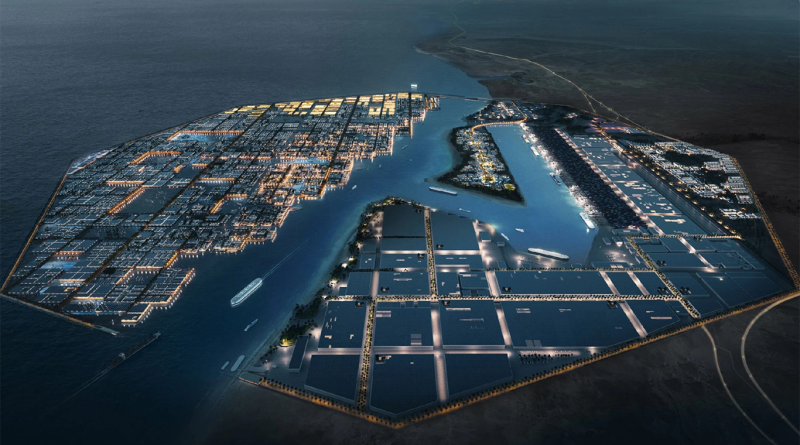Saudi Arabia Awards $1 Billion Port Contract to Propel Vision 2030
Saudi Arabia continues to make strides in its Vision 2030 agenda with the awarding of a $1 billion contract to develop the Oxagon port, a key component of the NEOM mega-city. The Oxagon port project represents a critical milestone in the country’s broader effort to diversify its economy and position itself as a global hub for advanced manufacturing and logistics. As part of the futuristic NEOM project, Oxagon is set to become the world’s largest floating structure, driving technological innovation and sustainable development in the region.
NEOM and Vision 2030 – A Futuristic Ambition
Vision 2030, Saudi Arabia’s ambitious economic diversification plan, aims to reduce the country’s dependence on oil revenues and transform it into a global investment powerhouse. Launched in 2016, the initiative outlines a broad framework for social, economic, and infrastructural reforms, with a strong emphasis on innovation, sustainability, and technology. At the heart of this vision is NEOM, a $500 billion high-tech mega-city that promises to be a beacon of futuristic living, combining smart technology, renewable energy, and cutting-edge infrastructure.
NEOM’s strategic location along the Red Sea gives it unparalleled access to global trade routes, enhancing Saudi Arabia’s connectivity with Europe, Asia, and Africa. By developing state-of-the-art urban centers such as Oxagon, NEOM aims to become a focal point for technological innovation and a model for sustainable living. The awarding of the $1 billion port contract is a significant step in realizing this vision, reflecting the government’s commitment to creating a diversified and resilient economy.
Oxagon – The Industrial Heart of NEOM
Oxagon, one of the key regions within the NEOM mega-city, is envisioned as a hub for advanced manufacturing, research, and logistics. Positioned at the intersection of some of the world’s busiest maritime routes, Oxagon is uniquely suited to becoming a global center for industry and trade. The region’s design reflects a commitment to sustainability, with plans to use 100% renewable energy and integrate smart city technologies to optimize operations and minimize environmental impact.
The Oxagon port will serve as the industrial heart of NEOM, providing a gateway for goods and services to flow into and out of the city. As the world’s largest floating structure, Oxagon is not only an architectural marvel but also a symbol of Saudi Arabia’s determination to push the boundaries of engineering and innovation. The development of the port will facilitate the movement of raw materials, finished goods, and components, reinforcing Oxagon’s role as a critical node in the global supply chain.
The $1 Billion Port Contract – Key Details and Stakeholders
The $1 billion contract to develop the Oxagon port marks a pivotal moment in NEOM’s development. The contract has been awarded to a consortium of leading international companies with expertise in port construction, logistics, and infrastructure. These firms will be responsible for designing, building, and managing the port, ensuring it meets the highest standards of efficiency, safety, and sustainability.
The port is expected to become operational by 2025, aligning with NEOM’s broader timeline for completion. Once finished, it will be equipped with advanced cargo handling facilities, automated systems, and smart logistics solutions, making it one of the most technologically advanced ports in the world. The development is also expected to create thousands of jobs, providing a significant boost to the local economy and contributing to Saudi Arabia’s efforts to reduce unemployment and increase female workforce participation.
Implications for Saudi Arabia’s Economy and Global Trade
The Oxagon port development is poised to have far-reaching implications for Saudi Arabia’s economy and its role in global trade. By establishing a cutting-edge logistics hub on the Red Sea, Saudi Arabia aims to capture a larger share of global maritime traffic and strengthen its position as a key player in the global supply chain. The port’s strategic location allows it to serve as a transshipment point for goods traveling between Europe, Asia, and Africa, enhancing the country’s trade connectivity and reducing dependence on the Strait of Hormuz.
In addition to boosting trade volumes, the port is expected to attract significant foreign investment, foster innovation, and drive economic growth. By providing world-class facilities and infrastructure, Saudi Arabia is positioning itself as an attractive destination for global manufacturers and exporters. This, in turn, will support the country’s broader efforts to diversify its economy, reduce its reliance on oil exports, and create a sustainable economic future.
Sources:
- MEED Article: NEOM awards estimated $1bn Oxagon port contract
- Additional references on Saudi Arabia’s Vision 2030, NEOM project details, and Middle East economic diversification efforts.
